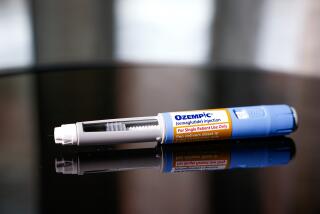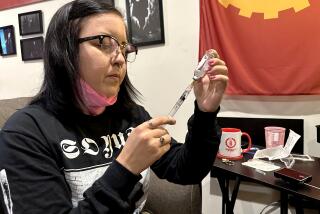Diabetes -- Darwinism in our time?
The steady dirge of diabetes swells all about us, dark and onerous. The condition is now estimated to affect 7% of California’s population, with some putting the figure closer to 10%. With new molecular diagnostics, the numbers get even grimmer, with pre-diabetes -- a risky level of sugar and inflammatory agents in the blood -- edging in on 20% of the state’s adult population. It is no surprise that a UCLA professor last week called the numbers “the tip of the iceberg.”
Or is it the beak of the finch? When a condition that can lead to disability and premature death affects so large a part of a population, what’s really going on?
One way to think about Type 2 diabetes is as evolution in our own time. Think about Darwin’s tale of the short-beaked finch, the one that couldn’t crack the best nuts on the Galapagos Islands and so died out, ceding its place to the finch with the curved, long beak. Type 2 diabetes marks the human short-beaked finch -- the ones whose genes and challenged pancreas can’t keep pace with today’s calorically unbalanced world, where sugary, fatty foods are abundant and our jobs pay us to be sedentary. Most of us are short-beaks.
Such a dynamic has unfolded at least once before, in Western Europe during the post-Renaissance period, when crop yields exploded, personal fortunes grew and famine -- the evolutionary driver of our genetic propensity to acquire and store calories by way of the so-called hungry gene -- became less frequent. This produced a growing population, mainly the rich and the new upper-middle class, who began displaying all the symptoms we now recognize as diabetic: unquenchable thirst (as described in the instructively titled “La Vita Sobria,” by Italian merchant-humanist Alvise Cornaro), numbness and pain in the extremities (often in the form of gout or metabolic arthritis), blindness (J.S. Bach, a diabetic, died after two eye operations) and, eventually, loss of limb to infection. Importantly, the period also produced the first literature of public and occupational health, with an emphasis on hygiene, self-control and more diagnostically attuned physicians.
That “cryptic epidemic” of Type 2 diabetes, as Jared Diamond has dubbed it, may well explain present-day Europe’s relatively mild increases. In terms of evolution, the continent has already been winnowed, the hungry gene at least partly eliminated, producing a population less vulnerable to the caloric hammer now banging away at the metabolism of the rest of the world. The European poor -- the 19th century’s version of today’s Latin American immigrant -- brought their hungry genes to America, where they still party on.
Of course, we are not finches. Even better, we are not 18th century burghers, who likely believed that their illnesses were somehow linked to the stars, Galenic humors, atmospheric miasmas or the twists of fate. We are, at least in the case of Type 2, engineers of our own evolution. Humans have invented relatively inexpensive tools to mitigate the ravages, or at least to grease the evolutionary pole.
The first of these tools, the prototype of today’s glucose meter, came into circulation in 1965. Today the palm-sized meter, lancet and strips allow individuals to determine and chart exactly how their metabolism is reacting to the modern environment of “diabesity.” (The very concept of diabesity -- the connection between sugary foods, obesity and diabetes -- originated at Childrens Hospital Los Angeles through the pioneering work of Dr. Fran Kaufman.) The meter is not a cure-all. But it gives us an evolutionary edge of which Bach’s physician never dreamed.
It’s not as easy to determine the origins of the second tool to mitigate our glucose evolution: the pedometer, or step counter. Its inventor may have been Thomas Jefferson (my choice), or Leonardo da Vinci (my wife’s). What we do know is this: If your pedometer counts fewer than 10,000 steps a day, your blood sugar can more easily get out of control. Beleaguered public health officials also know this. The pedometer is cheap and easy to understand, and it serves an important psychological role as a prompt toward exercise. That’s why you see them popping up everywhere.
Nevertheless, tools without teachers -- and the social and medical environments to support them -- don’t work. That is why California health officials, who are on the front lines of the diabesity fight, are pressing for a smarter, earlier and more sustained focus on glucose control. Much of this dynamism comes from Los Angeles’ leading medical institutions, UCLA and USC, whose underfunded teaching hospitals are in constant contact with the main Darwinian victims: the poor and the recently arrived.
Unfortunately, there isn’t yet much of a consensus about what to do. Solutions get snared in endless policy debates about medical insurance, state budgets and what might be called “anti-stigma” ideology--the notion that recognizing a health problem in a specific community will saddle said community with a negative image -- the immigrant, say, as destroyer of public health, the fatty as Medicare killer.
Fortunately, we’re moving beyond that nonsense. In fact, focusing on glucose control may be one way to get the dangers of obesity across without getting it entangled in the chubby politics of victimhood and identity. Here is one idea: Teach every California ninth-grader how to use a glucose meter, and use the state’s vast purchasing power to make the devices nearly free for every family. Next: Show every California fifth-grader how and why to use a pedometer -- and then give them one. Also: Include simple, glucose-control educational information in any application process for immigrants. Lastly, appoint and fund a state diabetes czar.
On this last, I can already hear the usual suspects screaming about big government. We’ll be sure to send them the huge state healthcare bill in 2020, when, if we don’t take such measures, the finch will start eating our wallets.
Greg Critser is the author of “Fat Land: How Americans Became the Fattest People in the World” and the forthcoming “Eternity Soup: Inside the Quest to End Aging.”
More to Read
A cure for the common opinion
Get thought-provoking perspectives with our weekly newsletter.
You may occasionally receive promotional content from the Los Angeles Times.










